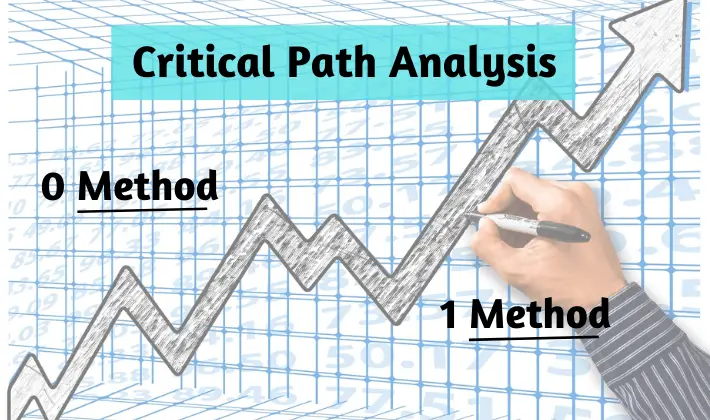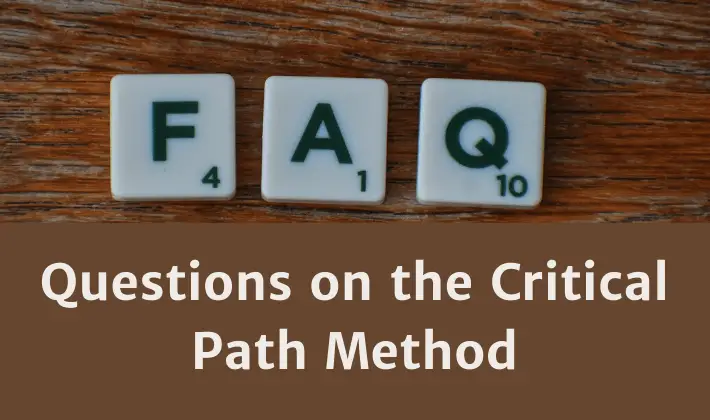Critical Path Analysis Example – Using 0 and 1 Method
I got introduced to Critical Path Analysis in the year 1997. I am a software engineer by education. I learned most of the project management concepts while managing software projects – Critical Path Analysis was one such concept. I learned about Critical Path while using MS Project.
MS Project, like many other scheduling tools, performs Critical Path Analysis using 1 method. It was the only method I knew, till I started preparing for the PMP exam. I learned about the 0 method during the exam prep. Initially, I thought 1 method was logical and 0 method was not correct.
But later, as I studied more, I realized that both both 0 and 1 methods are correct. Let us look at an example and do Critical Path Analysis using 0 and 1 methods.
Note: I will not go into the details of Critical Path Method (CPM) in this post. I am assuming that you already understand what Precedence Diagramming Method (PDM) is and you can solve a network diagram to determine the Critical Path.
I have written this post to differentiate between 0 method and 1 method. I have used Finish to Start relationship in this post to explain the difference. However, the concept is equally applicable for the other 3 types of PDM relationships.
Abbreviations Used
- ES – Early Start
- LS – Late Start
- EF – Early Finish
- LF – Late Finish
- P – Predecessor
- S – Successor
- CP – Critical Path
Critical Path Analysis Example – 0 Method
Example

I have purposefully used a very small example. We can concentrate on understanding the concept behind 0 and 1 methods, without getting bogged down in the nuances of CPM.
Major Principle
The work for an activity is done between the Start Period (ES or LS) and the Finish Period (EF or LF), but it does not include the Start Period. In our example the work for Activity B will happen in Period 6 and Period 7.
4 Main Formulas for 0 Method
Forward Pass Formulas
EF = ES + Duration
ESs = Maximum (EF of all the predecessors)
Backward Pass Formulas
LS = LF – Duration
LFp = Minimum (LS of all the successors)
Critical Path Analysis Example – 1 Method
Example

I have solved the same network diagram (as shown above) using the 1 method.
Major Principle
The work for an activity is done between the Start Period (ES or LS) and the Finish Period (EF or LF) inclusive of both the Periods. In our example the work for Activity B will happen on Period 6 and Period 7.
4 Main Formulas for 1 Method
Forward Pass Formulas
EF = ES + Duration – 1
ESs = Maximum (EF of all the predecessors) + 1
Backward Pass Formulas
LS = LF – Duration + 1
LFp = Minimum (LS of all the successors) – 1
A Case for 0 Method
This method is useful when the work is done in contiguous work periods. Let us look at some example scenarios where 0 method would be useful and logical.
Example Scenario I
Consider the Work Period as 24 hour workday. The activities in a network diagram would start on “End of the Day” and also finish on “End of the Day”.
Work starts at the end of Day 0 (2400 Hours of Day 0 or 0000 Hours of Day 1) and the duration is expressed in days. If the duration of an activity is n days, then the work would finish on End of Day n (2400 Hours).
In our example Activity B starts on End of Day 5 (or Start of Day 6) and finishes on End of Day 7.
Example Scenario II
Consider the Work Period as 1 hour. The activities in a network diagram would start on “Beginning of the Hour” and also finish on “Beginning of the Hour”.
Work starts at Hour 0 and the duration is expressed in hours. If the duration of an activity is n hours, then the work would finish at the Beginning of Hour n.
In our example Activity B starts on Beginning of Hour 5 and finishes on Beginning of Hour 7.
A Case for 1 Method
This method can be equally applied to the contiguous and non-contiguous work periods.
Example Scenario I
Consider the Work Period as 8 hour workday. The activities in a network diagram would start on “Beginning of the Day” and also finish on “End of the Day”.
Work starts at 9 am in the morning of Day 1 and the duration is expressed in days. If the duration of an activity is n days, then the work would finish at the end of Day n (5 pm in the evening).
In our example Activity B starts on Beginning of Day 6 (9 am) and finishes on End of Day 7 (5 pm).
Example Scenario II
Consider the Work Period as 1 hour. The activities in a network diagram would start on “Beginning of the Hour” and finish on “End of the Hour”.
Work starts at the start of 1st Hour (notice the change in semantics from the previous Scenario II) and duration unit is expressed in hours. If the duration of an activity is n hours, then the work finishes at the End of nth Hour.
In our example Activity B starts on Beginning of 6th Hour and finishes on End of 7th Hour.
Frequently Asked Questions
Again, it does not matter. Even though the PMBOK Guide 5th edition gives reference to 1 method, the exam questions can be solved by both the methods. You can refer to Figure 6.18 page 177 of the PMBOK Guide 5th edition.If the exam question is about determining the CP or calculating the float, you are safe with either method. But if the exam question is about determining the ES or LS, then there could be a confusion. However, the exam questions are well reviewed and they are without any ambiguity. So, it is highly unlikely that you will get confusing choices.
You can also refer to this forum discussion to see a sample exam question. If you are interested, you can buy the PMP Exam Formulas Guide mentioned in the forum discussion. It contains 49 formulas, concepts behind the formulas, 105 sample questions and a 14 day email course.
In many books and articles, you will find that the following formula for determining the Free Float.
(Free Float)p = ESs – EFp
Usually, this formula is written in books that follow 0 method. This formula works only for 0 method. It will not work for 1 method. Following is a more generic formula, which works for both 0 and 1 method.
(Free Float)p = ESs – ESp – (Duration)p
Over To You
Which method do you usually use for critical path analysis? Why? Please leave a comment.
Related Articles
19 Frequently Asked Questions on Critical Path Method
Total Float vs. Free Float
4 Steps to Solve PDM PMP Questions
Finish to Finish Relationship
Start to Start Relationship
Start to Finish Relationship
Finish to Start Relationship
PMP Exam Formulas
I have also compiled a PMP Formulas Cheat Sheet. It contains 45 formulas and 57 abbrviations. It will help you in your exam prep. It is the best and most comprehensive cheat sheet based on the PMBOK Guide 6th edition. You can download it free of cost for your studies.
If you are looking beyond a cheat sheet, then I would suggest you to buy detailed PMP Exam Formula Study Guide by Cornelius Fichtner. It contains detailed explanations of all the formulas along with examples and 105 practice questions.
Disclosure: This article contains affiliate links - it means that, if you buy from any of these links, then I will receive a small commission that would help me in maintaining this blog for free. However, for you, there is no extra cost. I recommend only those products that I believe will definitely help the certification aspirants.





![Finish to Start [FS] Relationship (Dependency) With Examples](https://www.pmbypm.com/wp-content/uploads/2014/06/finish-to-start.jpg)


In a case for 0 method-Scenario II- You mentioned, “The activities in a network diagram would start on “Start of the Hour” and also finish on “Start of the Hour”.” And you also mentioned, “In our example Activity B starts on Start of Hour 5 and finishes on Start of Hour 7.” As per this, the activity happens on 5th and 6th day,which I think is incorrect, as the activities are happening on 6th and 7th. Could you clarify this.
Hi Siva,
Thanks for the comment. I could not understand your confusion.
Both 0 method and 1 method are mathematical concepts. They can be used (adjusted) for hour or day scenarios. For 0 method I gave 2 scenarios.
1. Day scenario – B happens on Day 6 and Day 7 (same as your comment).
2. Hour scenario – B happens between Hour 5 & Hour 7 (same as your comment).
It is more about interpretation and mathematics then anything else. Hope it helps.